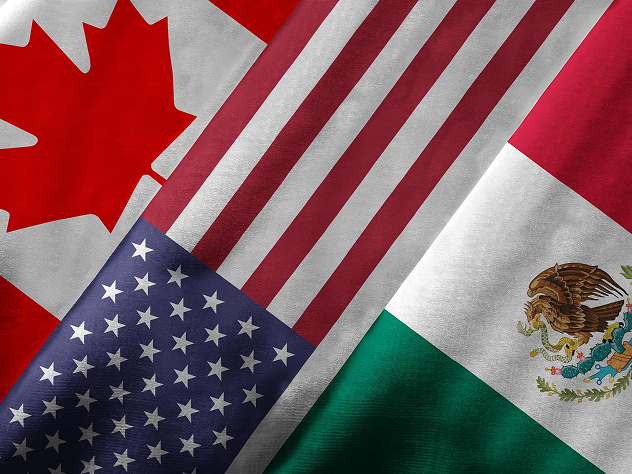Le projet de la Gestion des cotisations et des recettes de l’ASFC (GCRA) est une initiative pluriannuelle qui transformera la perception des taxes et des droits applicables aux marchandises importées au Canada.
La version 1 a été mise en ligne le 25 mai 2021 et permet à tous les importateurs de consulter leurs relevés de compte mensuels. Les importateurs doivent créer un compte pour accéder au portail en ligne et déléguer des accès à leur personnel et à leurs courtiers.
Il n'y aura aucun impact sur les dédouanements à la frontière jusqu'à la mise en service de la version 2 prévue au printemps 2022.
Configuration du compte d’utilisateur sur le portail de la GCRA
Les importateurs peuvent utiliser une CléGC ou un partenaire de connexion pour accéder au portail GCRA. Une fois connectés, les importateurs peuvent accéder à la page d’accueil et créer un compte. Chaque employé accédant au portail aura besoin d’un justificatif d'identité unique.
Pour plus d'informations sur la CléGC, cliquez ici. Pour plus d’informations sur les partenaires de connexion, cliquez ici.
Accès au compte d’entreprise
Les importateurs doivent disposer de plusieurs informations (afin d'accéder au compte dans le portail de la GCRA), y compris la dénomination sociale et l'adresse de l'entreprise.
L'entreprise devra répondre à deux des questions d'affinité suivantes :
- Le solde du dernier relevé de compte
- Le montant du dernier paiement
- Le total des droits et des taxes connexes (ligne 51 de B3) de l'une des 5 dernières transactions
Délégation de l’accès au compte sur le portail
Chaque utilisateur peut se voir attribuer un rôle prédéfini ainsi que des droits d’accès prédéfinis. Les entreprises doivent s'assurer que chaque rôle dispose d'un remplaçant capable de remplir les mêmes fonctions.
Au moment de configurer leur compte dans le portail, il est important que les importateurs établissent des plans d'intégration et de sortie bien définis.
Gestionnaire de compte d’entreprise (GCE)
-
Cet utilisateur a un accès complet à la gestion des comptes d’entreprise et du programme.
-
Il peut accepter de nouveaux employés dans l’entreprise et demander des relations de tiers avec les clients.
-
Ce rôle doit être confié à un utilisateur opérationnel actif, et pas nécessairement au propriétaire de l’entreprise.
Utilisateur non associé
- Cet utilisateur a créé son profil personnel sur le portail client de la GCRA, mais n’a pas encore été accepté en tant qu’employé de son entreprise.
Éditeur
- Cet utilisateur peut créer, modifier et visualiser tous les renseignements relatifs aux transactions d’un programme.
Lecteur
- Cet utilisateur peut voir tous les renseignements relatifs aux transactions d’un programme, mais il ne peut ni créer ni modifier les renseignements.
Pour plus d'informations sur la GCRA, veuillez consulter le site Web de l’ASFC. Vous pouvez également télécharger les documents pertinents à partir du compte Google Disque de l'ASFC.
La numérisation des processus de l'ASFC est essentielle pour consolider l’avantage concurrentiel de l'économie canadienne sur la scène mondiale. Je me réjouis des perspectives de développement que représente la GCRA.
Chad Swance, directeur des Affaires réglementaires et de la Conformité commerciale
CARM Q&A

 1. What has really changed for Release 1?
1. What has really changed for Release 1?
The CARM Portal will not change daily transactions. It will not impact releases at the border. Release 1 is a visibility platform with the additional capabilities of classification tools and rulings.

 2. Who within my organization should be setting up the CARM PORTAL account?
2. Who within my organization should be setting up the CARM PORTAL account?
Most businesses will create a partnership between their Trade Compliance team and their Accounts Payable team. Both teams are heavily impacted by the data contained in the portal.

 3. What is the difference of between a PAM and BAM?
3. What is the difference of between a PAM and BAM?
A BAM is a Business Account Manager and is responsible for all areas of a business within the portal. A PAM is a Program Account Manager and is only responsible for a subset of the business as defined by the BAM.

 4. Do each BAM/PAM require a GCKey or can a company use one and share it?
4. Do each BAM/PAM require a GCKey or can a company use one and share it?
Each individual should have their own unique sign in credentials. This allows for system traceability.

 5. How many BAM’s/PAM’s are we able to have?
5. How many BAM’s/PAM’s are we able to have?
The CBSA recommends that businesses have at least two (2) Business Account Managers (BAMs). Businesses can assign Program Account Managers (PAMs) as needed.

 6. Can a non-resident importer obtain a GCKey?
6. Can a non-resident importer obtain a GCKey?
Yes. For instructions on how to sign up for a GCKey, follow the user guide.

 7. Can a Broker pay on behalf of the clients?
7. Can a Broker pay on behalf of the clients?
For Release 1, there are no changes to the payment process. If a broker has been paying CBSA on behalf of its clients, the broker will continue to do. Under Release 2, the CBSA has indicated their intent to have all importers pay the CBSA directly.

 8. Can an importer search for a Broker in the CARM login?
8. Can an importer search for a Broker in the CARM login?
Yes. For instructions on delegation of authority, follow the guide.

 9. What is the minimum amount of a Bond that we can apply for?
9. What is the minimum amount of a Bond that we can apply for?
At present, the CBSA has indicated a minimum bond amount of $25,000.

 10. Do each of my Business Numbers require a bond?
10. Do each of my Business Numbers require a bond?
Yes. Every unique importer will require a minimum bond.

 11. What is the difference between a BN9 and a BN15?
11. What is the difference between a BN9 and a BN15?
The BN15 is a 15-digit Business Number that uses the legal entity’s:
-
Unique 9-digit root
-
2-character program identifier (identifying the government program for which the business is registered)\
-
4-digit account number (an incremental number assigned to each account the business has within each program).
The BN15’s structure identifies the business via the root and keeps track of the programs for which the business is registered via the various suffixes.

 12. How soon can I start setting up my CARM BOND ? Is a CARM BOND the same as a DUTY DIRECT BOND?
12. How soon can I start setting up my CARM BOND ? Is a CARM BOND the same as a DUTY DIRECT BOND?
You can set up a CARM Bond after the CBSA provides the final regulations or terms and conditions to the surety companies who will underwrite the proposed bonds. At present, the only type of bond that a resident importer can obtain is a Duty bond.

 13. Will there still be HVS and LVS shipments?
13. Will there still be HVS and LVS shipments?
Yes. There will still be high value and low value shipments, including CLVS – courier low value shipments.

 14. Where do I find the answers to the three questions posed during CARM portal registration process?
14. Where do I find the answers to the three questions posed during CARM portal registration process?
Importers should look at their Statement of Account. Importers should contact the CARM group to set up a Statement of Account.

 15. How does CARM impact the CBSA Canada Customs Coding Form (B3)?
15. How does CARM impact the CBSA Canada Customs Coding Form (B3)?
Under Release 2, the B3 will be replaced by the Commercial Accounting Declaration (CAD).

 16. How does CARM impact CBSA refund and adjustment requests / Canada Customs Adjustment Request (B2)?
16. How does CARM impact CBSA refund and adjustment requests / Canada Customs Adjustment Request (B2)?
The B2 or amendment process will be replaced at Release 2 by the CAD version control.

 17. Does the CARM portal allow importers to make electronic release requests for commercial import shipments, without the use of a broker/agent?
17. Does the CARM portal allow importers to make electronic release requests for commercial import shipments, without the use of a broker/agent?
No. The CARM portal does not have the functionality to transmit a release request. The portal pertains to the accounting/financial aspects of the clearance.

 18. My company contracts Kuehne+Nagel to manage all my import transactions and pay CBSA on my behalf. What remains the same under CARM? What are the major changes under CARM? Will Kuehne+Nagel still be my agent at the border?
18. My company contracts Kuehne+Nagel to manage all my import transactions and pay CBSA on my behalf. What remains the same under CARM? What are the major changes under CARM? Will Kuehne+Nagel still be my agent at the border?
Kuehne+Nagel will still be your agent at the border and submit all of the data necessary to clear and account for your imports. Under CARM, the importer will gain transactional visibility (Release 2) to your shipments at the border. Under CARM Release 2, the importer will be required to pay the CBSA directly through the portal.

 19. What is the new name and contact co-ordinates for CBSA CARM GROUP? (for inquiries & support)
19. What is the new name and contact co-ordinates for CBSA CARM GROUP? (for inquiries & support)
Importers can contact the CARM Client Support Helpdesk (CCSH) via their online web form or hotline.

 20. Is one Business Account Manager (BAM) enough?
20. Is one Business Account Manager (BAM) enough?
Importers should register more than one BAM for each importer account in their control. This redundancy provides vacation coverage and protects against unexpected absences.

 21. How long does it take to register for a GC Key.
21. How long does it take to register for a GC Key.
GC Key Registration is a process that takes most individuals less than 15 minutes.

 22. Which business number should I register?
22. Which business number should I register?
Ensure that you register each BN9 and RM extension that your organization imports under. Importers should validate their business numbers against recent B3 declarations.

 23. I have a complicated business name. What should I do?
23. I have a complicated business name. What should I do?
Many businesses are struggling with achieving an exact match to the CBSA’s database. If an entity is registered with the CRA as “ABC Ltd.” but entered into the CARM portal as “ABC Ltd” the user would receive an error. Importers can check their GST registry using the CRA’s GST Registry Tool.

 24. How can I pass the transaction number validation question?
24. How can I pass the transaction number validation question?
The CARM registration portal auto selects the transaction number for total duties and taxes. The value given cannot be a negative number. It will now accept 0.00. Companies who use multiple brokers to clear on their behalf may struggle with this data. Some companies have found that refreshing the screen or logging in an additional time has brought up a different transaction number. This enables them to enter a correct value.

 25. Where can I find my last payment amount?
25. Where can I find my last payment amount?
Importers who are GST and/or duty direct can look this up in their internal records. This question is particularly challenging for companies that do not pay the CBSA directly (GST and/or Duty Direct). Importers that are struggling with the data element can reach out to the CBSA for support using the online form or call 1-800-461-9999 menu option #2 (CARM).

 26. Where can I find my statement of account balance?
26. Where can I find my statement of account balance?
Importers who are not duty or GST direct may opt in to receive Daily notices (DNs) and Statement of Account (SOA) documents directly from the CBSA. Importers can reach out to the CBSA for support using the online form or call 1-800-461-9999 menu option #2 (CARM).










